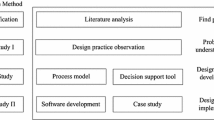Abstract
Conceptual design is the key phase which confirms the principle solution that contains a great deal of innovative ideas. Theory of inventive problem solving (TRIZ) and theory of constraints (TOC) are two techniques for systematic innovation that can help designers and companies achieve innovative product solutions. TOC is used to discover contradictions and TRIZ is used to solve the conflicts in the process of product conceptual design, so we describe a process model to realize the theoretical interaction based on TRIZ and TOC. Beginning with the interaction between users and product to be designed, this paper makes a survey of user demand, summarizes in which stage of product development is and analyzes the directions of product technology evolution by selecting evolution routes of technical system. After design conflicts in product system are determined, the designer achieve the solutions of each sub-function of product according to their experience and heuristic association by using TRIZ tools. Designers let the users select the sub-function solutions from the morphological matrix and combine into a few suitable programs. Finally, the designer conduct program evaluation to obtain the optimal product solution by analytic hierarchy process (AHP). As a case study, an innovative design of the UV lampblack purification machine has been achieved with application of the process model.












Similar content being viewed by others
References
Hsu, W., Woon, I.M.Y.: Current research in the conceptual design of mechanical products. Comput. Aided Des. 30(5), 377–389 (1998)
Liu, X.M., Huang, S.P., Chen, Y.T.: Research and application:conceptual integrated model based on TRIZ and bionics for product innovation. Int. J. Interact Des. Manuf. 1–9 (2016)
Ma, J.H., Tan, R.H.: Creative design by integerating TRIZ and ABD. J. Eng. Des. 13(4), 193–198 (2006)
Nadeau, J.P., Fischer, X.: Research in interactive design. In: Virtual, interactive and integrated product design and manufacturing for industrial innovation, vol. 3. Springer, Berlin (2010). ISBN 13:978-2817801681
Yuan, F., Wang, T.Y., Nie, H.J.: Function and principle innovative design of mechanical products based on TRIZ/FA. Comput. Integr. Manuf. Syst. 12(2), 205–209 (2006)
Tan, R.H., Zhang, R.H., Liu, F., Yang, B.J.: Two stages analogy-based conceptual design based on TRIZ. Comput. Integr. Manuf. Syst. 12(3), 328–334 (2006)
Strattona, R., Mannb, D.: Systematic innovation and the underlying principles behind TRIZ and TOC. J. Mater. Proc. Technol. 136(3), 120–126 (2003)
Nasim, N., Zhaleh, P., Mojtaba, M.: Integrated framework for using TRIZ and TOC together: a case study. Int. J. Bus. Innov. Res. 5(4), 309–324 (2011)
Ellen, D.H., Dettmer, H.W.: Breakthrough innovation in conflict resolution-marrying TRIZ and the thinking process. TRIZ Journal, http://www.triz-journal.com. 5 (1999)
Moura, E.C.:TOC trees help TRIZ. TRIZ Journal, http://www.triz-journal.com, 9 (1999)
Luke, S.R.: A conceptual design tool for engineers: an amalgamation of theory of constraints, theory of inventive problem solving and logic. Old Dominion University, Virgmia (2002)
Cherifi, A., Dubois, M., Gardoni, M., Tairi, A.: Methodology for innovative eco-design based on TRIZ. Int. J. Interact. Des. Manuf. 3(9), 167–175 (2015)
Houssin, R., Renaud, J., Coulibaly, A., Cavallucci, D., Rousselot, F.: TRIZ theory and case based reasoning: synergies and oppositions. Int. J. Interact. Des. Manuf. 3(9), 177–183 (2015)
Altshuller, G.S.: Creativity as an exact science. CRC, New York (1984)
Zhang, J.H., Tan, R.H., Yang, B.J., Chen, Z.S.: Study on technique of product technology evolutionary. J. Eng. Des. 15(3), 157–163 (2008)
Shao, J.J., Ke, D.J., Lin, M.: An application of thinking process of TOC in a manufacturing company. Ind. Eng. Manag. 11(1), 104–109 (2006)
Xu, X.Y., Coulibaly, S.: Product Design Problem-Solving by Integrating TRIZ and TOC. J. Univ. Sci. Technol. China 35(6), 927–935 (2005)
Liu, X.Z., Qi, G.N., Fu, J.Z., Fan, B.B., Xu, J.J.: A design process model of integrated morphological matrix and conflict resolving principles. Journal of Zhejiang University (Engineering Science Edition). 46(12), 2243–2251 (2012)
Saaty, T.L., Hu, G.: Ranking by eigenvector versus other methods in the analytic hierarchy process. Appl. Math. Lett. 11(4), 121–125 (1998)
Nikoloulopoulos, A.K., Joe, H., Chaganty, N.R.: Weighted scores method for regression models with dependent data. Biostatistics 12(4), 653–665 (2011)
Wang, R., Rui, Y.N., Yin, H., Yang, H.: The Design of a kind of New Jet type Kitchen Lampblack Purification Machine. Journal of Soochow University (Engineering Science Edition). 25(2), 7–9 (2005)
Liu, X.M., Tian, S.L., Wang, Z.W.: Defining method research of technological conflict based on improved current reality tree. Comput. Integr. Manuf. Syst. 19(2), 348–353 (2013)
Acknowledgments
We would like to thank the reviewers for their valuable comments and all the users involved in the survey and design. The research is supported in part by Chinese National Natural Science Foundation (No. 50375045) and Natural Science Foundation of Fujian Province (No. 2011J01302).
Author information
Authors and Affiliations
Corresponding author
Rights and permissions
About this article
Cite this article
Huang, S., Liu, X. & Ai, H. Research on application of process model for product concept creative design based on TRIZ and TOC. Int J Interact Des Manuf 11, 957–966 (2017). https://doi.org/10.1007/s12008-016-0316-5
Received:
Accepted:
Published:
Issue Date:
DOI: https://doi.org/10.1007/s12008-016-0316-5




